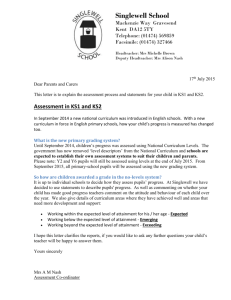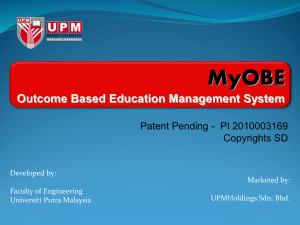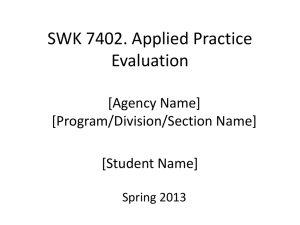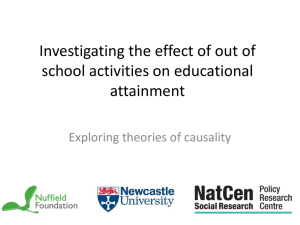to the College of Engineering Dean`s Office
advertisement
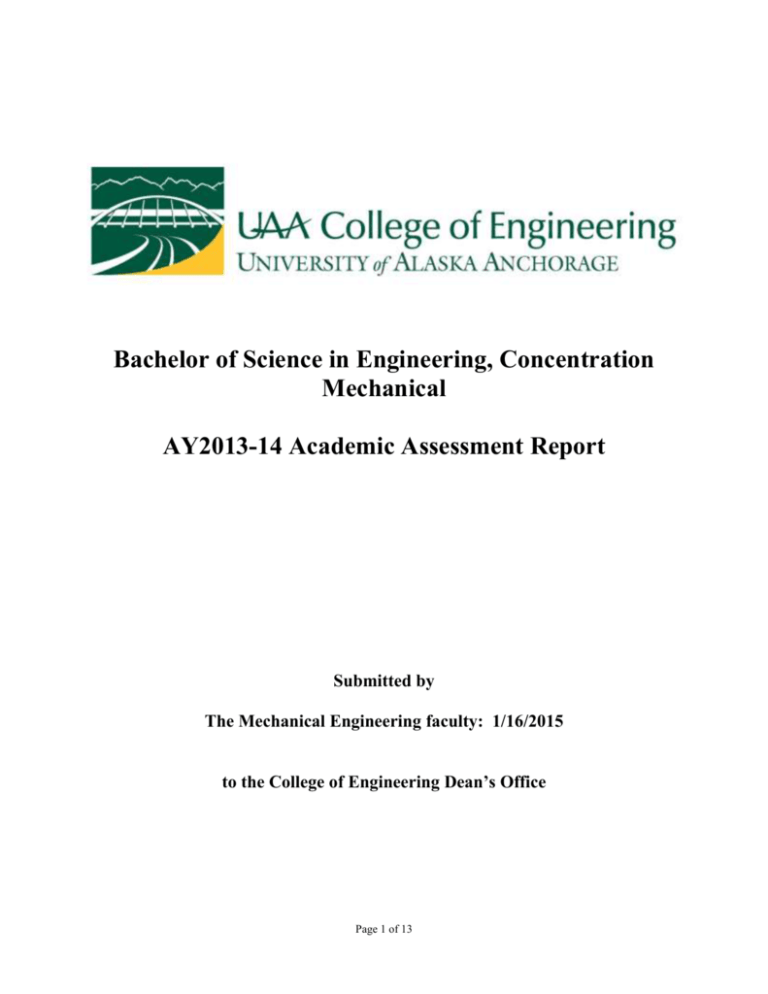
Bachelor of Science in Engineering, Concentration Mechanical AY2013-14 Academic Assessment Report Submitted by The Mechanical Engineering faculty: 1/16/2015 to the College of Engineering Dean’s Office Page 1 of 13 OVERVIEW OF THE YEAR’S ASSESSMENT ACTIVITIES AND ASSESSMENT SCHEDULE This year, course-level assessment data were collected for Outcomes a, b, e, f, i and j. In addition, we gave our senior exit survey to all of this year’s graduates, which collects indirect assessment data on every outcome. Outcome AY 2012-13 AY 2013-14 AY 2014-15 AY 2015-16 AY 2016-17 AY 2017-18 a b X c d X f X X X e h X X X X i j X X X X g X X X X X X k X X X IMPROVEMENTS TO THE ASSESSMENT PROCESS We did not make changes to our assessment process this year. In the last complete round of assessment, which ended in AY2013-14, we made several changes to our Performance Indicators and assessment rubrics, but we did not feel the need to make additional changes this year. CONSTITUENT INPUT The ME faculty met with the ME Curriculum Advisory Board on Wednesday, April 23, 2014. The minutes from that meeting are on file with our department. We sought feedback on the competencies that they look for in potential hires for entry-level positions within their companies. Highlights from this discussion include IT-related skills and networking engineering. The ability to build and query databases for handling very large datasets. Communication (strongly emphasized by all), including verbal and nonverbal, and the ability to express technical ideas to non-technical people. A broad-based education, with a focus on an ability to learn – employers do not expect their entry-level employees to be trained as specialists. Emphasis on a strong grounding in “the basics,” including math and science. As the result of this feedback, the faculty plan to discuss with the CS&E faculty possibilities for including network-related skills in our curriculum. We might also consider soliciting feedback from nontechnical people at student project presentations (e.g. senior design presentations). ASSESSMENT OF PROGRAM STUDENT LEARNING OUTCOMES Outcome a: Outcome a: an ability to apply knowledge of mathematics, science and engineering 1. Selects appropriate theory, model or governing equation 2. Understands simplifying assumptions or limitations of the chosen model 3. Implements theory, model or governing equation correctly to perform analysis Page 2 of 13 Direct CLA results for Outcome a 60% Percentage of students 50% 40% 30% 20% 10% 0% Unsatisfactory Developing Satisfactory Excellent Level of attainment Selects appropriate theory Understands simplifying assumptions Correctly performs analysis Direct Assessment Measures Course ME A441 Measure Final, Q2 Final, Q2 Final, Q2 Quiz 2 Final, Q4 AM session ES A208 FE Exam PI Assessed 1 2 3 1 3 1-3 Attainment Level 63% 63% 75% 57% 70% 100% Indirect Assessment Measures Measure Senior exit survey Attainment Level 100% Overall attainment level (80/20 weight factor for direct vs. indirect measures): 77% Faculty analysis of student performance relative to this outcome: The ME Faculty acknowledge that most courses involve “handholding” when it comes to selecting appropriate governing equations and simplifying assumptions, which may partially explain the lower levels of attainment for PIs 1 and 2. The suggestion was made at the 2012 Assessment Retreat that instructors should incorporate more fully symbolic questions into their homework and exams to break students of the habit of thinking of engineering problem solving in terms of number crunching. Some of these symbolic questions will be assessed in the next cycle in order to collect data on their effect. Page 3 of 13 Student attainment of this outcome is below expectation because this attainment level has been artificially raised by the FE Exam scores and Senior Exit Survey results. We consider the CLA-measured level of 66% to be more accurate, and below target levels. Plans for enhancing student attainment of the outcome: The ME Faculty have made a series of improvements to the core curriculum during AY 2010-11 and AY 2011-12 which we believe add rigor to the program and address these issues with Outcome a. These changes include replacing the rapid-paced ES A208 Engineering Mechanics: Statics and Dynamics with separate courses in Engineering Statics (ES A209) and Engineering Dynamics (ES A210), and also adding laboratory aspects to ME A334 Materials Science, ME A414 Thermal System Optimization and ME A441 Heat and Mass Transfer. Report on the impact of prior efforts to enhance student attainment of this outcome: The prior efforts described above went into effect very recently and their effects are expected to be more evident in the next assessment cycle. Outcome b: Outcome b: an ability to design and conduct experiments, as well as analyze and interpret data 1. Selects appropriate equipment or tools, such as software, theoretical equations, etc. 2. Makes appropriate use of data collection/analysis techniques 3. Combines or integrates information from multiple sources Direct CLA results for Outcome b 100% Percentage of students 90% 80% 70% 60% 50% 40% 30% 20% 10% 0% Unsatisfactory Developing Satisfactory Level of attainment Selects appropriate equipment/tools Uses appropriate data collection techniques Combines information from multiple sources Direct Assessment Measures Page 4 of 13 Excellent Course ME A441 ENGR A251 ME A438 Measure Lab report Lab report Lab report Final, Q4 Lab report Lab report Final presentation PI Assessed 1 2 3 1 2 3 1-3 Attainment Level 67% 75% 96% 78% 74% 63% 91% Indirect Assessment Measures Measure Senior exit survey Attainment Level 100% Overall attainment level (80/20 weight factor for direct vs. indirect measures): 82% Faculty analysis of student performance relative to this outcome: The ME faculty have anecdotally noticed a positive trend with regard to Outcome b as it relates to students’ capstone design projects. In the past, students tended to focus on simply building a prototype without predicting the performance ahead of their test via numerical or analytical means. This year, every capstone design group incorporated some amount of analysis of their final product into their final reports, and some groups did impressive amounts of analysis. It is believed that the addition of ME A280 Solid Modeling for Engineers to the core curriculum has played a role in making students more comfortable with adding numerical analysis techniques, such as the finite element method, to their arsenal. ME A280 was taught for the first time in fall of 2011 and is offered every semester. Student attainment of this outcome is at expectation. This attainment is above target levels at the time of graduation, although direct CLA has revealed individual courses and PIs that have much room for improvement. Plans for enhancing student attainment of the outcome: A potential problem on the horizon is that the only class that emphasized LabView as a tool (ENGR A251 Engineering Practices III) has been eliminated from the core curriculum. The ME faculty made this change as part of the continuous improvement process. ENGR A251, which was a 3-credit, 200-level introduction to experimental techniques, was replaced with three course-specific labs added to the upper level. These were ME A334L Materials Science Laboratory, ME A414L Thermal System Design Laboratory and ME A441L Heat and Mass Transfer Laboratory. Not only did the AY2010-11 constituent survey indicate strong support for this move among current students and alumni, the ME faculty also believe that more lab experience at the upper level will improve student performance on Outcomes b, d and e. In addition, the large number of lab reports that students will have to write is expected to improve their written communication skills and performance on Outcome g. There are many advantages to remove ENGR A251 from the curriculum, but one disadvantage is that the curriculum no longer contains a course that makes extensive use of LabView. Report on the impact of prior efforts to enhance student attainment of this outcome: The prior efforts described above went into effect very recently and their effects are expected to be more evident in the next assessment cycle. Page 5 of 13 Outcome c: Not assessed this year Outcome d: Not assessed this year Outcome e: Outcome e: an ability to identify, formulate, and solve engineering problems 1. Identifies relevant known and unknown factors 2. Provides appropriate analysis of elements of the solution 3. Assesses the validity of the solution based on mathematical or engineering insight Direct CLA results for Outcome e 100% Percentage of students 90% 80% 70% 60% 50% 40% 30% 20% 10% 0% Unsatisfactory Developing Satisfactory Excellent Level of attainment Identifies known/unknown factors Provides appropriate analysis Assesses validity of solution Direct Assessment Measures Course ME A313 ME A306 ME A438 Measure Project report Project report Project report Project report, subproblems 1,2,4 Project report, subproblems 1,3,5-8 Project report, subproblems 1-8 Final presentation Final report Final report Final report PI Assessed 1 2 3 1 Attainment Level 75% 75% 58% 76% 2 67% 3 52% 1-3 1 2 3 92% 82% 82% 100% Page 6 of 13 Indirect Assessment Measures Measure Senior exit survey Attainment Level 100% Overall attainment level (80/20 weight factor for direct vs. indirect measures): 81% Faculty analysis of student performance relative to this outcome: The best assessment of Outcome e at the time of graduation is ME A438 Design of Mechanical Engineering Systems. The ME faculty have observed that student capstone groups have been getting better than in previous years about analyzing the validity of their designs. This may be partially due to the addition of ME A280 Solid Modeling for Engineers to the curriculum, which has made students more comfortable with using solid modeling and numerical analysis techniques to vet potential designs, rather than relying on a less precise trial-anderror method. This might also be partially due to the fact that capstone design groups are now more strongly encouraged to seek help from a faculty advisor with expertise in an area relevant to their project in addition to the ME A438 course instructor. These advisors are able to tell student groups what forms of validation are typically looked for in the particular design problem they have been assigned. Student attainment of this outcome is at expectation. This attainment is above target levels at the time of graduation, although direct CLA has revealed individual courses and PIs that have much room for improvement. Plans for enhancing student attainment of the outcome: The attainment level of PI 3 is much lower in the other courses assessed, which are typically taken in the junior year and well before ME A438. These results suggest that students have not been used to thinking about the validity of their solutions before they get as far as capstone design. There are many ways in which individual instructors can emphasize verification in their classes. In lab classes, students could be asked to write a section on whether their results make sense and why. In traditional lecture-format classes, instructors could work order of magnitude verifications, unit checks, and other forms of verification into homework, projects and exams. Report on the impact of prior efforts to enhance student attainment of this outcome: The ME Department is currently conducting its second-ever full assessment cycle and does not have this data. Outcome f: Outcome f: an understanding of professional and ethical responsibilities 1. Has knowledge of a professional code of ethics 2. Analyzes ethical issues Page 7 of 13 Direct CLA results for Outcome f 100% 90% Percentage of students 80% 70% 60% 50% 40% 30% 20% 10% 0% 1 2 3 4 Level of attainment Has knowledge of professional code of ethics Analyzes ethical issues Direct Assessment Measures Course ENGR A151 ENGR A192 FE Exam Measure Final, Q13 Final , Q16 Final, Q19 Final, Q24 Final AM Session PI Assessed 1 2 2 2 2 1-2 Attainment Level 50% 80% 95% 90% 46% 100% Indirect Assessment Measures Measure Senior exit survey ENGR A151 end-of-semester survey Attainment Level 100% 80% Overall attainment level (80/20 weight factor for direct vs. indirect measures): 79% Faculty analysis of student performance relative to this outcome: The direct CLA results that deal mainly with the existence of the Code of Ethics for professional engineers, and with ethical issues faced by professional engineers, include the ENGR A192 Engineering Seminar exam and Question 1 from the ENGR A151 Engineering Practices I final. The student level of achievement in these areas is around half. The percentage of ME freshmen achieving “Satisfactory” or “Excellent” performance on the ENGR A192 exam is approximately 46%, and the percentage of ME freshmen choosing the correct answer for Question 1 on the ENGR A151 exam is 50%. The direct CLA results that deal with ethical issues facing engineering students (citing sources, collaborating on coursework, etc.) include Questions 16, 19 and 24 on the ENGR Page 8 of 13 A151 final. Here, student performance is better as a whole, with between 80-95% of students picking the correct answer in all cases. These results suggest that our freshmen are more familiar with ethical issues facing students than with those facing working professionals. This is unsurprising, given that college freshmen have years of experience with ethical issues facing students, and likely very little experience with ethical issues facing working professionals. Student attainment of this outcome is above expectation, although our current practice of doing CLA closer to the freshman year is problematic because it does not give us a sense of student achievement of this Outcome at the time of graduation. Plans for enhancing student attainment of the outcome: An obvious shortcoming of the assessment data presented here is a lack of direct CLA data from classes taken closer to graduation. To rectify this, students will be assessed for Outcome f in ME A438 Design of Mechanical Engineering Systems during the next round of assessment. Report on the impact of prior efforts to enhance student attainment of this outcome: The ME Department is currently conducting its second-ever full assessment cycle and does not have this data. Outcome g: Not assessed this year Outcome h: Not assessed this year Outcome i: Outcome i: a recognition of the need for, and the ability to engage in, life-long learning 1. Identifies opportunities for continued education in the field 2. Indicates interest in continuing education 3. Participates in professional activities, such as taking the FE Page 9 of 13 Direct CLA results for Outcome i 100% Percentage of students 90% 80% 70% 60% 50% 40% 30% 20% 10% 0% Unsatisfactory Developing Satisfactory Excellent Level of attainment Identifies opportunities for continued education Indicates interest in continuing education Participates in professional activies, such as taking the FE Direct Assessment Measures Course ENGR A151 Senior exit survey Measure Focus group Focus group Q19 Q3 PI Assessed 1 2 1 3 Attainment Level 50% 75% 56% 56% Indirect Assessment Measures Measure Senior exit survey Attainment Level 100% Overall attainment level (80/20 weight factor for direct vs. indirect measures): 67% Faculty analysis of student performance relative to this outcome: Direct CLA of Outcome i was performed in ENGR A151 Engineering Practices I and also using the senior exit survey. ENGR A151 is the introduction to engineering course taken by freshmen in mechanical, civil, electrical and computer systems engineering students. The instructor for ENGR A151 reported at the 2012 Assessment Retreat that students were eager to come up with ideas and discuss continuing education, which is reflected in the 75% attainment level for PI 2. However, as freshmen, their knowledge of opportunities for continuing education in the field is limited. The students focused on internet and campus resources, and were unaware of professional society resources, short courses, and graduate study opportunities. Two questions on the senior exit survey allow for direct assessment of Outcome i. Question 19 asks students where they hope to be in five years, and what resources they plan to utilize to make their goals happen. Students who identified at least one continuing Page 10 of 13 education resource (graduate school, professional societies, obtaining a PE license, etc.) were graded as at least “Satisfactory.” Question 3 asks students if they have passed the FE. Students were graded “Satisfactory” if their answer was either “yes” or “results pending.” ME students at UAA are strongly encouraged to take the FE, and most choose to do so eventually. The results of this round of assessment suggest relatively low levels of attainment for this outcome, particularly PI 2. Anecdotally, the ME faculty have observed that many of our students do have an interest in continuing education (for example, 73% of respondents to the 2012 Alumni Survey indicated an interest in a master’s program in ME, if UAA was to offer one). It is possible that our students are not prepared to articulate concrete plans for lifelong learning at the time of graduation. Student attainment of this outcome is below expectation, possibly due to the way in which the data were collected, as described above. Plans for enhancing student attainment of the outcome: At the very least, professional society membership should be emphasized throughout the ME program. Representatives from various student chapters of professional societies sometimes ask to speak about their activities to ME classes, and this can be further encouraged. Also, ME faculty can start emphasizing opportunities for continuing education when we meet with juniors and seniors for academic advising. Report on the impact of prior efforts to enhance student attainment of this outcome: The ME Department is currently conducting its second-ever full assessment cycle and does not have this data. Outcome j: Outcome j: a knowledge of contemporary issues 1. Identifies contemporary issues important in engineering 2. Describes those issues in a factually correct manner, supported with evidence, explained in sufficient detail and properly documented Page 11 of 13 Direct CLA results for Outcome j 100% 90% Percentage of students 80% 70% 60% 50% 40% 30% 20% 10% 0% 1 2 3 4 Level of attainment Identifies contemporary issues Describes in factually correct, properly documented manner Direct Assessment Measures Course ME A664 Measure Final, Q1 PI Assessed 1 Attainment Level 75% Indirect Assessment Measures Measure Senior exit survey Attainment Level 100% Overall attainment level (80/20 weight factor for direct vs. indirect measures): 80% Faculty analysis of student performance relative to this outcome: Direct CLA data for Outcome j was only collected in ME A664 Corrosion Processes and Engineering during the latest round of assessment. ME A664 is an advanced elective rather than a required course, although it is an elective with very high enrollment (24 students were assessed). Student attainment of this outcome is above expectation, although assessment of this Outcome also has room for improvement, as direct CLA was only done using an advanced elective, rather than a required course. Plans for enhancing student attainment of the outcome: It would of course be ideal to collect most if not all direct CLA data in required core courses. This issue was discussed by the ME faculty at the 2012 assessment retreat. Outcome j could potentially be assessed in any engineering course by asking the students to examine how the topics they learn in class relate to contemporary engineering practice. In the next round of assessment, a required core course will be used to assess Outcome j. Page 12 of 13 Report on the impact of prior efforts to enhance student attainment of this outcome: The ME Department is currently conducting its second-ever full assessment cycle and does not have this data. Outcome k: Not assessed this year. Page 13 of 13

